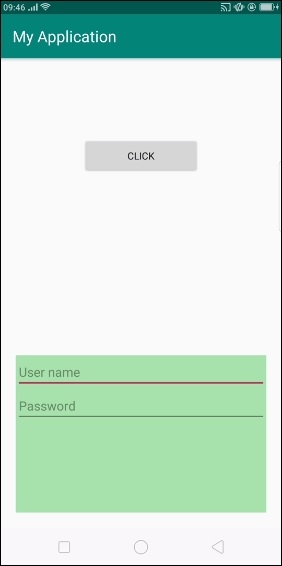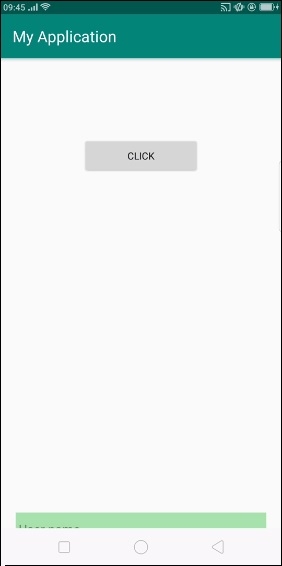
- Trending Categories
 Data Structure
Data Structure Networking
Networking RDBMS
RDBMS Operating System
Operating System Java
Java MS Excel
MS Excel iOS
iOS HTML
HTML CSS
CSS Android
Android Python
Python C Programming
C Programming C++
C++ C#
C# MongoDB
MongoDB MySQL
MySQL Javascript
Javascript PHP
PHPPhysics
Chemistry
Biology
Mathematics
English
Economics
Psychology
Social Studies
Fashion Studies
Legal Studies
- Selected Reading
- UPSC IAS Exams Notes
- Developer's Best Practices
- Questions and Answers
- Effective Resume Writing
- HR Interview Questions
- Computer Glossary
- Who is Who
How to Show and hide a View with a slide up/down animation in android?
This example demonstrate about how to Show and hide a View with a slide up/down animation in android.
Step 1 − Create a new project in Android Studio, go to File ⇒ New Project and fill all required details to create a new project.
Step 2 − Add the following code to res/layout/activity_main.xml.
<?xml version = "1.0" encoding = "utf-8"?> <RelativeLayout xmlns:android = "http://schemas.android.com/apk/res/android" xmlns:tools = "http://schemas.android.com/tools" android:layout_width = "match_parent" android:layout_height = "match_parent"> <Button android:id = "@+id/button" android:layout_centerHorizontal = "true" android:layout_marginTop = "100dp" android:layout_width = "150dp" android:text = "Click" android:layout_height = "wrap_content"/> <LinearLayout android:id = "@+id/view" android:background = "#a6e1aa" android:orientation = "vertical" android:layout_alignParentBottom = "true" android:layout_width = "match_parent" android:layout_margin = "20dp" android:layout_height = "200dp"> <EditText android:hint = "User name" android:layout_width = "match_parent" android:layout_height = "wrap_content" /> <EditText android:hint = "Password" android:layout_width = "match_parent" android:layout_height = "wrap_content" /> </LinearLayout> </RelativeLayout>
In the above code, we have taken button to show /hide linear layout with animation.
Step 3 − Add the following code to src/MainActivity.java
package com.example.andy.myapplication;
import android.support.v7.app.AppCompatActivity;
import android.os.Bundle;
import android.view.View;
import android.view.animation.TranslateAnimation;
import android.widget.Button;
import android.widget.LinearLayout;
public class MainActivity extends AppCompatActivity {
boolean opened;
LinearLayout view;
@Override
protected void onCreate(Bundle savedInstanceState) {
super.onCreate(savedInstanceState);
setContentView(R.layout.activity_main);
view = findViewById(R.id.view);
view.setVisibility(View.INVISIBLE);
findViewById(R.id.button).setOnClickListener(new View.OnClickListener() {
@Override
public void onClick(View v) {
if(!opened){
view.setVisibility(View.VISIBLE);
TranslateAnimation animate = new TranslateAnimation(
0,
0,
view.getHeight(),
0);
animate.setDuration(500);
animate.setFillAfter(true);
view.startAnimation(animate);
} else {
view.setVisibility(View.INVISIBLE);
TranslateAnimation animate = new TranslateAnimation(
0,
0,
0,
view.getHeight());
animate.setDuration(500);
animate.setFillAfter(true);
view.startAnimation(animate);
}
opened = !opened;
}
});
}
}In the above code, we are showing and hiding linear layout using translate animation as shown below -
To show the view, use the following code -
TranslateAnimation animate = new TranslateAnimation( 0, 0, view.getHeight(), 0); animate.setDuration(500); animate.setFillAfter(true); view.startAnimation(animate); To hide the view, use the following code - TranslateAnimation animate = new TranslateAnimation( 0, 0, 0, view.getHeight()); animate.setDuration(500); animate.setFillAfter(true); view.startAnimation(animate);
Let's try to run your application. I assume you have connected your actual Android Mobile device with your computer. To run the app from android studio, open one of your project's activity files and click Run ![]() icon from the toolbar. Select your mobile device as an option and then check your mobile device which will display your default screen −
icon from the toolbar. Select your mobile device as an option and then check your mobile device which will display your default screen −

When user click on button it will show like the above screen and now click on same button to hide the view as shown below -

Click here to download the project code

